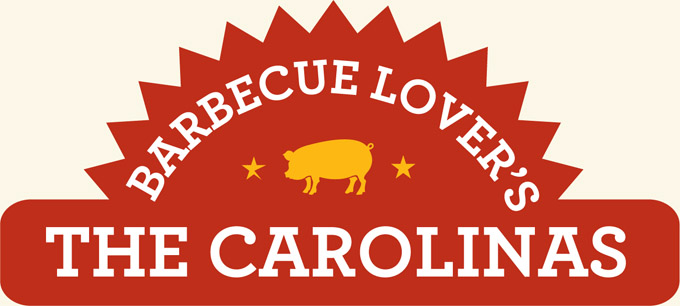
Restaurants, Markets, Recipes & Traditions

Robert F. Moss
Globe
Pequot
GUILFORD, CONNECTICUT
For Bobby
Globe
Pequot
An imprint of Rowman & Littlefield
Distributed by NATIONAL BOOK NETWORK
Copyright 2015 by Rowman & Littlefield
All photos by the author unless otherwise noted.
Maps: Alena Joy Pearce Rowman & Littlefield
All rights reserved. No part of this book may be reproduced in any form or by any electronic or mechanical means, including information storage and retrieval systems, without written permission from the publisher, except by a reviewer who may quote passages in a review.
British Library Cataloguing in Publication Information Available
Library of Congress Cataloging-in-Publication Data
Moss, Robert F.
Barbecue lovers the Carolinas : restaurants, markets, recipes & traditions / Robert F. Moss.
pages cm
Includes bibliographical references and index.
ISBN 978-0-7627-9198-9 (paperback : alkaline paper) ISBN 978-1-4930-1601-3 (electronic)
1. BarbecuingNorth CarolinaGuidebooks. 2. BarbecuingSouth CarolinaGuidebooks. 3. RestaurantsNorth CarolinaGuidebooks. 4. RestaurantsSouth CarolinaGuidebooks. 5. MarketsNorth CarolinaGuidebooks. 6. MarketsSouth CarolinaGuidebooks. I. Title.
TX840.B3M68 2015
641.7609756dc23
2015008981
 The paper used in this publication meets the minimum requirements of American National Standard for Information SciencesPermanence of Paper for Printed Library Materials, ANSI/NISO Z39.48-1992.
The paper used in this publication meets the minimum requirements of American National Standard for Information SciencesPermanence of Paper for Printed Library Materials, ANSI/NISO Z39.48-1992.
All the information in this guidebook is subject to change. We recommend that you call ahead to obtain current information before traveling.
CONTENTS
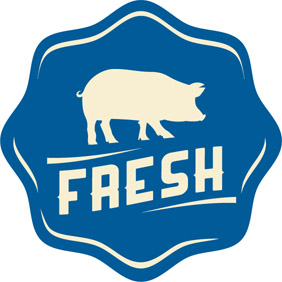
ABOUT THE AUTHOR
Robert F. Moss is a food writer and culinary historian living in Charleston, South Carolina. He is the Contributing Barbecue Editor for Southern Living , the Southern Food Correspondent for Serious Eats , and a frequent contributor to the Charleston City Paper . His work has also appeared in publications such as Garden & Gun , the Los Angeles Times , the Charlotte Observer , and Early American Life . Robert is the author of Barbecue: The History of an American Institution (2010), the first full-length history of barbecue in the United States, and Going Lardcore: Adventures in New Southern Dining (2012), a collection of essays about dining in the modern South. A native of Greenville, South Carolina, Robert attended Furman University and received a Ph.D. in English from the University of South Carolina.
ACKNOWLEDGMENTS
T his book wouldnt be possible without the contributions of many barbecue lovers in the Carolinas and beyond. John Shelton Reed, William McKinney, and Jeff Allen helped me track down worthy restaurants to include in the guide, and Jeff introduced me to the fine art of cinderblock pit construction and all-night whole hog cookery. Many thanks as well go to Rodney Scott of Scotts Bar-B-Que in Hemingway, South Carolina, for sharing so many tips and insights and so much fantastic barbecue over the past few years.
Robert Donovan, Denny Culbert, Nicholas McWhirter, and Jonathan Boncek contributed splendid photographs for the book. A special thanks to all the pitmasters who took the time to talk with me about their craft, particularly Samuel Jones of Skylight Inn, Chip Stamey of Stameys, and Aaron Siegel of Fiery Rons Home Team BBQ, and to barbecue evangelists Lake High and Jim Early for their guidance, recipes, and enduring passion for traditional barbecue.
I still owe my agent, David Hale Smith, a trip to Scotts for helping get this thing off the ground. Tracee Williams and Lynn Zelem at Globe Pequot took a raw manuscript and transformed it into a finished book.
Most of all, I have to thank my wife, Jennifer, and my two sons, Bobby and Charlie, who accompanied me on multiple barbecue tours across the Carolinas. It wouldnt have been nearly as much fun without you guys along.
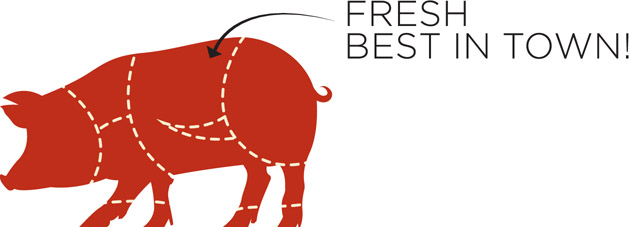
INTRODUCTION
T o outsiders, many aspects of barbecue in the Carolinas seem odd. For starters, theres our obsession with pork. Send a Carolinian up to a buffet with instructions to bring you back some barbecue, and its pretty certain what youll get. That buffet may be brimming with baby back ribs, chicken quarters, and maybe even sliced brisket, all of which have been slow cooked on a hickory-fired pit, but the plate that comes back to you will invariably be piled high with pork.
This is not to say that no one in the Carolinas ever eats brisket, but only a handful of restaurants in the region actually cook it well. Barbecued chicken is a Carolina menu staple, almost as omnipresent as pig, but it will always be called just that: barbecued chicken. The phrase pork barbecue sounds acceptable if somewhat redundant to Carolinian ears, but youll never hear the term chicken barbecue . It just sounds wrong. Barbecue , used as a noun, means pork, though you can use it as a verb to mean any of the lesser meats cooked via barbecue techniques.
Theres not a single restaurant in this guide that does not serve pork (be it pulled, chopped, sliced, or all of the above). But thats not the only distinctive characteristic to barbecue in the Carolinas. There are also our unique barbecue stewsBrunswick in North Carolina, hash and rice in South Carolina. The Brunswick variety is well known in Virginia and Georgia as well (in fact, it originated in Virginiasee The Origin of Brunswick Stew sidebar, in the Whole Hogs & Vinegar Sauce chapter), but hasha rich, viscous concoction created to use up all the parts of the pig that you couldnt barbecueis something almost unheard of beyond the Palmetto State. The sauces in the Carolinas are distinctive, too. Theres the fiery, fundamental vinegar-and-pepper sauce of Eastern North Carolina and the Pee Dee region of South Carolina, the light vinegar-and-tomato based dip universal in the Piedmont of North Carolina, and the tangy, sweet, and bright-yellow mustard-based sauce that so baffles newcomers to the Midlands of South Carolina.
Each region has its own signature side dishes, too. Youll find boiled potatoes and corn sticks in Eastern North Carolina, red slaw and hush puppies in the Piedmont, and big fluffy onion rings in and around Charleston. Unique to the lower portions of South Carolina is the presence of rice at barbecue restaurants, which is fitting because, during the 18th and 19th centuries, rice formed the foundation of the states economy. These days, the region may import long-grained rice from Louisiana or overseas, but its residents still tap into dining customs established centuries ago, and rice lives on in the form of hash and rice as well as pilau and chicken bog.
Barbecue in North Carolina is often discussed as if it stands alone, separately, from whats found in South Carolina. Most commentators note that the Tar Heel State has two dominant styles, Eastern and Piedmont, and partisans wrangle passionately over which is best. Meanwhile, South Carolina is typically said to have four distinct barbecue styles, defined primarily by the sauce used to dress the meat once its cooked. But, if you expand your purview to the Carolinas as a whole, you realize that the dotted line on the map that zigzags from Sunset Beach all the way west to the Chattooga River really doesnt mean that much. The mode of cooking that originated in the Piedmont of North Carolinapork shoulders roasted over hickory coals in closed brick pits and dressed with a light tomato-and-vinegar saucelong ago snuck over the state line into the Upstate counties of South Carolina. A different barbecue traditionwhole hogs cooked on open pits and basted with a fiery pepper-laced vinegar sauceis practiced in very much the same manner in the Pee Dee section of South Carolina as it is in the eastern part of the Tar Heel State. The distinctive Midlands South Carolina style, with its yellow mustard sauce and mysterious hash and rice, has made its way down to the coast around Charleston, while the counties along the Savannah River in South Carolina sometimes use a thick, red tomato-based barbecue sauce that is more akin to whats found on the Georgia side of the river than it is in the rest of the Carolinas. Once you get up into the mountainous regions of the two states, all bets are off.
Next page
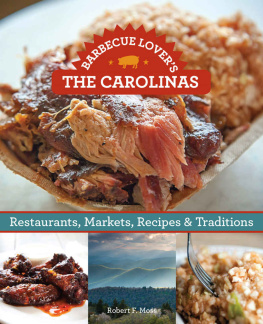
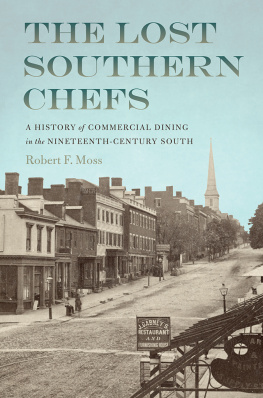


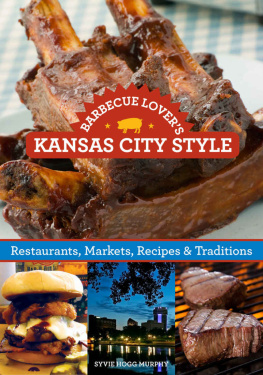
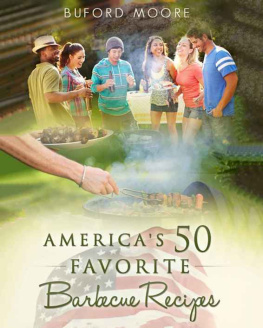


 The paper used in this publication meets the minimum requirements of American National Standard for Information SciencesPermanence of Paper for Printed Library Materials, ANSI/NISO Z39.48-1992.
The paper used in this publication meets the minimum requirements of American National Standard for Information SciencesPermanence of Paper for Printed Library Materials, ANSI/NISO Z39.48-1992.
